For reciprocating air compressors (the type you’re likely to have in your shop) you want to use a non-detergent, straight weight oil. This can be either synthetic (Amsoil makes an excellent 30/40 wgt., non-detergent compressor oil) or organic. For organic, look for S.A.E. 30 weight, non-detergent. The reason is that reciprocating compressors are splash lubricated, and there is a lot of churning action going on. The non-detergent property keeps the parts effectively lubricated.
When sizing an air compressor, add the cumulative air demand in CFM (all tools and equipment have a CFM consumption rating) that you will be deploying simultaneously, and divide this figure by 3.75 to get the Horse Power rating you will need. The figure of 3.75 holds true only for a high quality, two stage compressor, such as a Saylor/Beall or a Bel Aire. For the inferior product that you buy at Menards or Lowes, the figure is more like 2.25.
Never locate your air compressor in a parts room or storage room where windshield washer solvent, or other solvent based products will be located. The compressor, after all, takes in the surrounding air (and any impurities that it may contain) compresses this air and then supplies your tools with this air. If it contains solvent fumes, your tools won’t last long.
It is not always necessary to choose the largest tank available for a given size of compressor. Your air piping acts as a storage tank, and will prevent the compressor from running continuously.
Never pipe directly into your air compressor tank. You always want to install a flex hose from the tank to the air pipe or tube. This is to allow for vibration of the compressor.
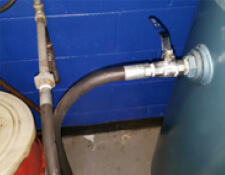
A magnetic motor starter is generally required on a heavy duty compressor. The compressors that you purchase at Menard’s or Home Depot are light duty, and usually employ a motor with built in thermal overload protection. The Mag Starter, as it is commonly called, protects the motor on start up, when amp draw is highest, and if there is a malfunction and the motor load exceeds its rating. We always quote the mag starter as part of the compressor, so you won’t need to source one later. Here is what the mag starter looks like:
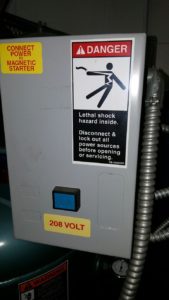
Exterior View
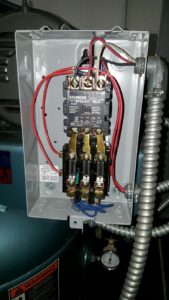
Interior View (Note the Bi-Metal Heaters)
To minimize problems with the feet on the bottom of the compressor tank cracking or the welds from failing, always install vibration pads under the feet. These are cork and rubber pads that absorb vibration and cut down a bit on the noise that the compressor generates.
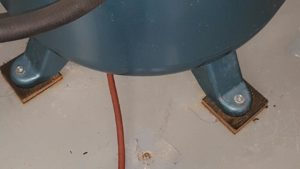
Speaking of compressor noise…..I once received a phone call from a muffler shop franchisee who complained that his compressor was consuming oil. I assumed the problem was related to blow-by from bad compressor rings. When I arrived, he showed me his compressor, and he was delighted to show my his home made “Compressor Noise Abatement” system (my term, not his). The noise abatement system consisted of a full blown automotive exhaust muffler system installed on the air intake of the compressor. I will say that the compressor was extremely quiet. The negative aspect of the system was that he had given his compressor a bad case of COPD, or Chronic Obstructive Pulmonary Disease-HIS COMPRESSOR COULDN”T BREATH. Consequently, the compressor head was red hot, and it was burning oil like crazy. The moral of the story? Don’t obstruct the air intake of your compressor. Leave the factory installed filter manifold in place, and change the filters as recommended! Here’s what the factory set up looks like:
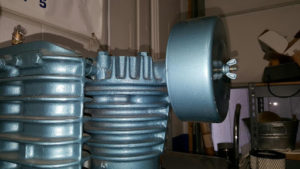
When ordering a compressor, you must specify voltage and phase, as they relate to your electric service. The most common requirement is 208/230 volt single phase, but you never know. I’ve had lots of customers get this one wrong. If you’re not sure, call your electric utility company, or an electrician. Additionally, you usually need at least a 30 amp breaker, depending on motor size.
There is this misconception out there that stationary rotary screw compressors are less noisy than their reciprocating or piston counterparts. This is not necessarily true. In fact, apples for apples, screw compressors are at least as loud as reciprocating compressors. The noise reduction comes from the sound attenuating enclosure that screw compressors are often sold with. You can get the same type of enclosure with reciprocating compressors. Bottom Line? If the compressor is going in your main shop area (rather than a separate room) you probably want to order it with some type of sound attenuation.
Screw type compressors typically max out at 100 psi. If you need higher pressure and are set on purchasing rotary screw, make sure you order the high pressure option. 100 psi typically doesn’t cut the mustard for a vehicle maintenance/automotive setting.
So what is the point of ordering a rotary screw compressor? Air volume and efficiency are the primary advantages. You get higher air volume for the same horse power on a screw compressor. Also, you can get a much higher air volume in a rotary screw. For example, you aren’t going to get 200 cfm from a recip, but this size and larger, is readily available in a screw type.